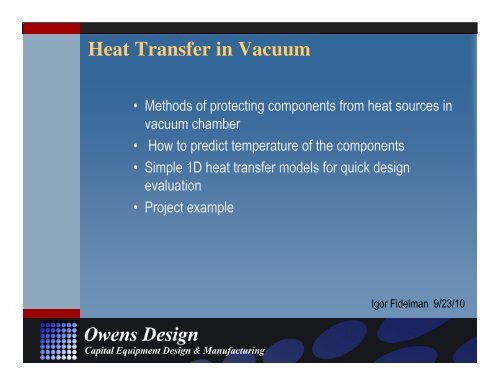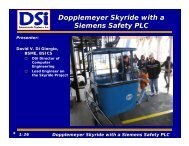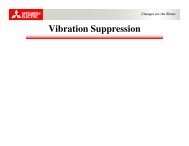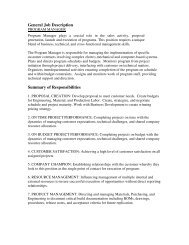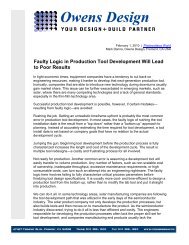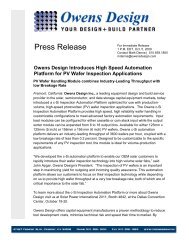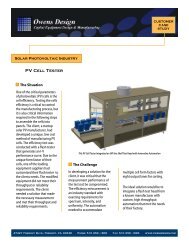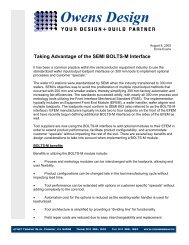Heat Transfer in Vacuum - Owens Design
Heat Transfer in Vacuum - Owens Design
Heat Transfer in Vacuum - Owens Design
Create successful ePaper yourself
Turn your PDF publications into a flip-book with our unique Google optimized e-Paper software.
<strong>Heat</strong> <strong>Transfer</strong> <strong>in</strong> <strong>Vacuum</strong><br />
• Methods of protect<strong>in</strong>g components from heat sources <strong>in</strong><br />
vacuum chamber<br />
• How to predict temperature of the components<br />
• Simple 1D heat transfer models for quick design<br />
evaluation<br />
• Project example<br />
Igor Fidelman 9/23/10
What needs to be protected:<br />
• O-r<strong>in</strong>gs, plastic parts (limited service temperature)<br />
• Mechanisms ( thermal expansion )<br />
• Chamber walls ( prevent<strong>in</strong>g deposition )<br />
• Feedthroughs ( proper function )
Modes of heat transfer: radiation and conduction<br />
(convection: low pressure chambers and frequent pump<strong>in</strong>g/vent<strong>in</strong>g )<br />
Methods of protection:<br />
• water cooled chamber walls or baffles,<br />
• <strong>in</strong>creased thermal conductive path<br />
• use of low thermal conductivity materials (quartz,<br />
opaque quartz, ceramics, SST)<br />
• radiation shields<br />
• gas assisted cool<strong>in</strong>g
Opaque quartz<br />
<strong>Heat</strong> source<br />
O-r<strong>in</strong>g<br />
Water<br />
channel<br />
Clear quartz<br />
Wafer<br />
Cool<strong>in</strong>g gas<br />
Chamber wall<br />
Radiation<br />
shields<br />
Th<strong>in</strong> wall:<br />
Increased thermal<br />
path
Thermal radiation.<br />
• Wavelength: 0.1 – 100 micrometers<br />
• Black body emits E=s*T^4 (W/m^2)<br />
Stefan-Boltzmann constant s=5.66e-8 (W/m^2*K^4)<br />
• Real body emits E= e*s*T^4 (W/m^2)<br />
e – emissivity (0-1)
Emissivity<br />
Depends on material and surface conditions<br />
SST, polished 0.27-0.29<br />
SST, oxidized 0.53-0.87<br />
Alum<strong>in</strong>um, polished 0.04-0.09<br />
Alum<strong>in</strong>um, anodized 0.4-0.6<br />
Opaque quartz 0.92<br />
Alum<strong>in</strong>a 0.9
• Absorptivity, reflectivity, transmissivity<br />
a + r + t = 1
More complications:<br />
Dependence of optical properties on wavelength<br />
Transmittance of 1mm thick clear fused quartz
More complications:<br />
Dependence of optical properties on temperature<br />
Emissivity of 0.725mm Si wafer
More complications:<br />
Spectral distribution of radiation energy.<br />
Maximum energy is emitted at: 2897.6/T(K) microns
More complications:<br />
Reflection – specular, diffusive
Approximation for eng<strong>in</strong>eer<strong>in</strong>g calculations<br />
• all surfaces are gray: absorptivity = emissivity, does not<br />
depend on wavelength ( rarely exist <strong>in</strong> real life, many<br />
materials are gray over certa<strong>in</strong> wavelength ranges )<br />
• all surfaces are opaque<br />
• all surfaces are diffusive<br />
• all surfaces are at uniform temperature<br />
Q :=<br />
⎛<br />
⎝<br />
1 − e<br />
1<br />
e ⋅A 1 1<br />
⎡<br />
⎣<br />
( ) 4 − ( T 2 ) 4<br />
σ⋅<br />
T 1<br />
⎞<br />
⎠<br />
+<br />
1<br />
A ⋅F 1 12<br />
+<br />
⎤<br />
⎦<br />
⎛<br />
⎝<br />
1 − e<br />
2<br />
e ⋅A 2 2<br />
⎞<br />
⎠
View Factors<br />
Fraction of energy leav<strong>in</strong>g surface 1 which reaches surface 2
Simple 1D Model<br />
Tw = const<br />
Tl = f (Cv,m)<br />
L<strong>in</strong>er (top)-Chamber wall<br />
Qr=f (e,T,F,A )<br />
Wafer –<br />
Chamber wall<br />
Qr=f (e,T,F,A )<br />
Qr Wafer-L<strong>in</strong>er<br />
Qr=f (e,T,F,A )<br />
<strong>Heat</strong>er-Wafer<br />
Qr=f (e,T,F,A )<br />
Tw = f (Cv,m)<br />
L<strong>in</strong>er (bottom)-<br />
Chamber wall<br />
Qr=f (e,T,F,A )<br />
Th = const
120<br />
115<br />
110<br />
Simple 1D model -results<br />
650<br />
600<br />
550<br />
500<br />
450<br />
400<br />
350<br />
300<br />
250<br />
200<br />
150<br />
100<br />
50<br />
0<br />
0<br />
5<br />
10<br />
15<br />
20<br />
25<br />
30<br />
35<br />
40<br />
45<br />
50<br />
55<br />
60<br />
65<br />
70<br />
T,C<br />
75<br />
80<br />
85<br />
105<br />
100<br />
95<br />
90<br />
time,sec<br />
wafer l<strong>in</strong>er
Tak<strong>in</strong>g it a step further<br />
Q radiation<br />
Q convection/conduction<br />
Q radiation<br />
Q convection/conduction<br />
Q conduction<br />
Q radiation<br />
Q convection/conduction<br />
Q radiation<br />
Q convection/conduction
1D Model - Results<br />
base plate<br />
heater<br />
susc. bottom<br />
susceptor 2<br />
susceptor 3<br />
susceptor 4<br />
susc. top<br />
shower head<br />
wafer<br />
temperature, °C<br />
850<br />
840<br />
830<br />
820<br />
810<br />
800<br />
790<br />
780<br />
770<br />
760<br />
750<br />
740<br />
730<br />
720<br />
710<br />
700<br />
690<br />
680<br />
670<br />
660<br />
650<br />
640<br />
630<br />
620<br />
610<br />
600<br />
4990 5000 5010 5020 5030 5040 5050 5060 5070 5080 5090 5100<br />
time, sec
1D Model - Results<br />
base plate<br />
heater<br />
susc. bottom<br />
susceptor 2<br />
susceptor 3<br />
susceptor 4<br />
susc. top<br />
shower head<br />
wafer<br />
temperature, °C<br />
850<br />
840<br />
830<br />
820<br />
810<br />
800<br />
790<br />
780<br />
770<br />
760<br />
750<br />
740<br />
730<br />
720<br />
710<br />
700<br />
690<br />
680<br />
670<br />
660<br />
650<br />
640<br />
630<br />
620<br />
610<br />
600<br />
590<br />
580<br />
570<br />
560<br />
550<br />
5000 5100 5200 5300 5400 5500 5600<br />
time, sec
1D Model - Results<br />
940<br />
920<br />
900<br />
880<br />
860<br />
840<br />
temperature, °C<br />
820<br />
800<br />
780<br />
760<br />
740<br />
720<br />
700<br />
base plate<br />
heater<br />
susc. bottom<br />
susceptor 2<br />
susceptor 3<br />
susceptor 4<br />
susc. top<br />
shower head<br />
wafer<br />
680<br />
660<br />
640<br />
620<br />
600<br />
4900 5000 5100 5200 5300 5400 5500 5600<br />
time, sec
Project example
Problem:<br />
• protect chamber from high energy ion beam<br />
• keep temperature of the shields below 150 deg C<br />
Solution:<br />
Use pure alum<strong>in</strong>um shields bolted to water cooled Al6061<br />
supports
Project example<br />
SHIELDS
Project example<br />
Cool<strong>in</strong>g<br />
channels<br />
shield
960<br />
930<br />
900<br />
870<br />
840<br />
810<br />
Project example<br />
150<br />
140<br />
130<br />
120<br />
110<br />
100<br />
90<br />
80<br />
70<br />
60<br />
50<br />
40<br />
30<br />
20<br />
10<br />
0<br />
0<br />
30<br />
60<br />
90<br />
120<br />
150<br />
180<br />
210<br />
240<br />
270<br />
300<br />
330<br />
360<br />
390<br />
420<br />
450<br />
480<br />
510<br />
540<br />
570<br />
600<br />
630<br />
660<br />
690<br />
720<br />
780<br />
750<br />
time, sec<br />
sac.plate cool.plate w ater exit T<br />
temperature, C
Conclusions<br />
• Thermal behavior of the chamber components have to be<br />
carefully evaluated when design<strong>in</strong>g a vacuum chamber with a<br />
heat source.<br />
• A simple 1D model allows to quickly estimate steady state and<br />
transient temperature of the parts.


